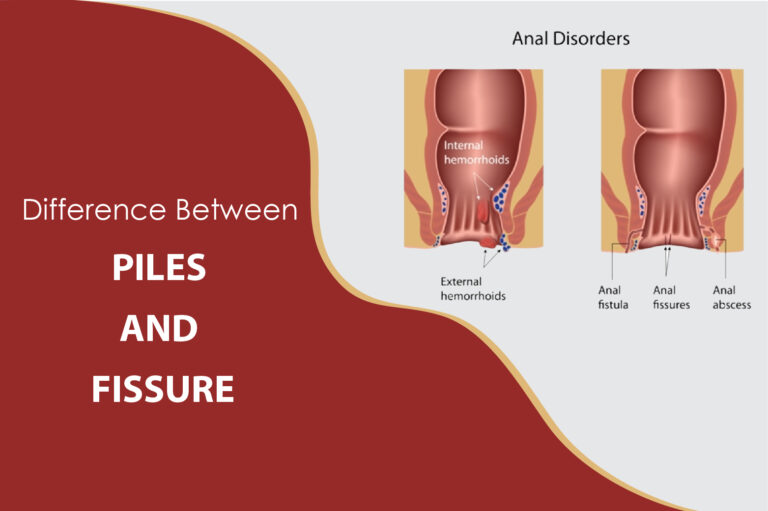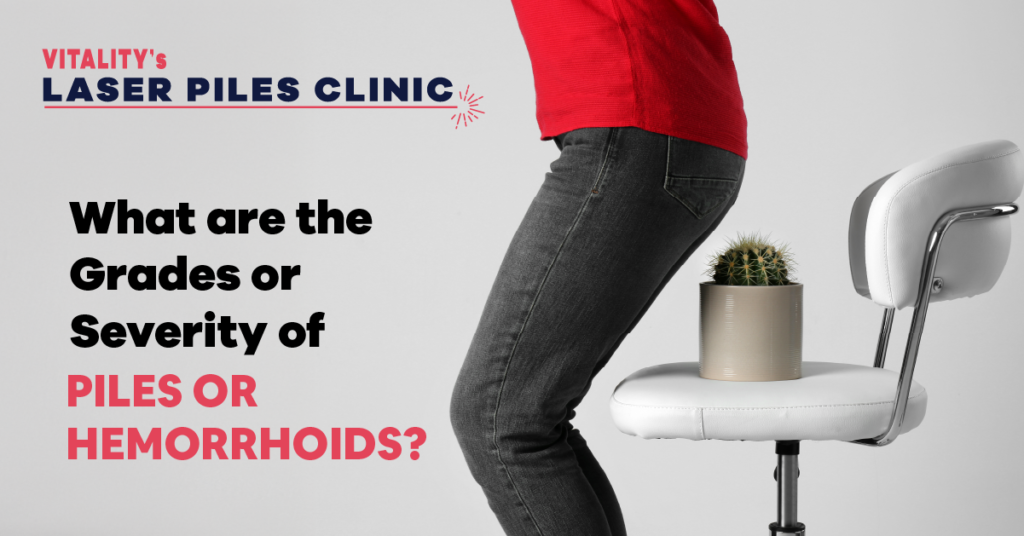Table of Contents
- Piles
- 4 stages of Piles
- Anal Fissure
- Diagnosis of Anal Fissures
- Differences between Piles and Fissure
- Treatment of Piles
- Treatment for Fissure
- Conclusion
Piles
The word ‘piles’ is used to identify a group of related medical conditions with similar underlying causes and symptoms. Piles, or hemorrhoids, are enlarged blood vessels found inside or around the bottom (the rectum and anus).
4 stages of Piles
- Stage 1 is when you have a pile, but no enlarged hemorrhoids protrude out of the anus. At this stage, you won’t experience any symptoms.
- Stage 2 is when a prolapse (protrusion) of hemorrhoids during a bowel movement, but they reduce spontaneously afterward. You may experience a mild discomfort and a feeling that your bowels haven’t fully emptied after having a poo.
- In stage 3, the prolapsed hemorrhoids always protrude from the anus and need to be manually pushed back into position. There’s usually some discomfort or pain in the anal region and a feeling of fullness in the rectum after having a poo.
- Stage 4 is when the hemorrhoids are permanently prolapsed and cannot be pushed back into position manually.
Anal Fissure
An anal fissure is a tear or lesion of the anal canal, which can cause severe pain. These tears happen when you strain while passing stool (for example, pushing too hard to have a bowel movement). It can also happen during childbirth or as a result of injury.
Diagnosis of Anal Fissures
In most cases, your doctor can diagnose anal fissures just by looking. If you have severe pain or other complications, your doctor may refer you to a specialist in colon and rectal diseases (proctologist).
If your doctor suspects that you have an underlying condition such as Crohn’s disease or ulcerative colitis, they may order tests to confirm the diagnosis, including:
¬ Blood tests. Your doctor may test a sample of your blood for signs of infection or other conditions.
¬ Stool sample. Your doctor may check a sample of your stool for signs of infection.
¬ Sigmoidoscopy. This procedure allows your doctor to examine the lower part of your colon (sigmoid colon) with a sigmoidoscope — a thin tube with a light and camera attached.
¬ Flexible Sigmoidoscopy is less invasive than colonoscopy, doesn’t require sedation, and takes about 10 minutes to complete. But it’s not used as often for diagnosing anal fissures because it doesn’t allow visualization of the entire length of the large intestine (colon).
¬ Colonoscopy. During this procedure, your doctor uses a long, flexible tube (colonoscope) to view the entire length of your
You will hear medical professionals use the terms “anal fissure,” “prolapsed hemorrhoids,” or “rectal prolapse” interchangeably with the word “piles.” This is because piles is an umbrella term for various anal complaints.
There are significant differences between a pile and a fissure. Nobody can deny it. However, a piles and a fissure are often confused for one another by the people, especially when they do not deal with professional works. Are you confused about the difference between piles and fissures? Most people are. However, understanding their differences is vital to a doctor’s diagnosis and the patient’s treatment plan.
Differences between Piles and Fissure
- Symptoms of piles are not noticeable in the earlier stages but cause a lot of pain and discomfort and pain in the later stages, often leading to bleeding or mucus discharge. In comparison, fissure causes pain and discomfort since the beginning of the disease. Bleeding is not generally observed in the early stages of the fissure.
- Chronic cough, long-term constipation, and pregnancy exert a lot of pressure on veins in the anal area, leading to piles. In contrast, Crohn’s Disease is the leading cause of Fissure.
- Piles are mostly painless and unnoticeable. Fissures cause a lot of pain. In the case of fistulas, pus is discharged out of the anal area.
- The early stages of piles may be curable with medication, lifestyle changes, diet, and precautions. Whereas medication helps the first stage of the fissure, the treatment is slow. Doctors generally advise Lateral Sphincterotomy for fissure, which gives instant relief.
Treatment of Piles
The first line of treatment for most piles is having a high-fiber diet (having plenty of fruit, vegetables, and cereals, and drinking lots of water) and taking regular exercise. This will make passing stools easier and help treat the cause of the piles.
- If you have bleeding from your back passage or if simple measures do not help your symptoms, several treatments are used to reduce or remove piles.
- Rubber band ligation – a rubber band is placed around the base of the pile to cut off its blood supply. The pile then shrinks and falls off within a week.
- Injecting piles with a special chemical solution can shrink them, so they fall off in a few days.
- Infrared photocoagulation (also called infrared coagulation) uses infrared light to make the pile fall off.
- Sclerotherapy uses an injection into the base of the pile to shrink it; this method is used for smaller piles. Bipolar diathermy uses an electric current passed through a small probe that has been inserted into the pile; this makes it shrink, so it falls off after about 2 weeks.
Treatment for Fissure
The key objectives of fissure treatments are to relax the anal sphincter by the passage of soft stool to promote quick healing. In case of an acute fissure, the doctor prescribes mild medication and suggests eating a healthy, fiber-rich diet with a lot of water and other healthy fluids for recovery.
Open surgery for fissures is painful and takes a long time to heal. Therefore, the best treatment for fissure is laser surgery, which takes 30 minutes to give a pain-free and permanent cure for fissure. On the other hand, the surgical means to get a cure for acute fissures is suggested for patients with acute fissures.
At Vitality’s Laser Piles Clinic, a range of treatments are on offer depending on the diagnosis, ranging from Sphincterotomy & Fissurectomy to Pilonidal Sinus & Rectopexy.
Conclusion
As shared earlier, Piles & Anal Fissure has many common symptoms ranging from painful bowel movements, blood in the stool or toilet paper, constipation, pain, swelling, redness, or sore skin around the anal area and often mistook for one-another. It’s essential to, however, note that they are two different diseases and hence have different treatments.
It’s highly advisable to consult a medical expert for advice and guidance before deciding and following a course of action.
Vitality’s Laser Piles Clinic is a chain of specialty clinics with a presence in 8 different locations in Hyderabad. With the latest in technology & equipment and a team of experienced doctors, we provide the best and most trusted Laser treatment in a pain-free manner for piles, anal fissures, and other related diseases.
To know more or book an appointment, call us on (+91) 910 850 3674 / (+91) 7799 016 016 or drop a mail to support@laserpiles.com


